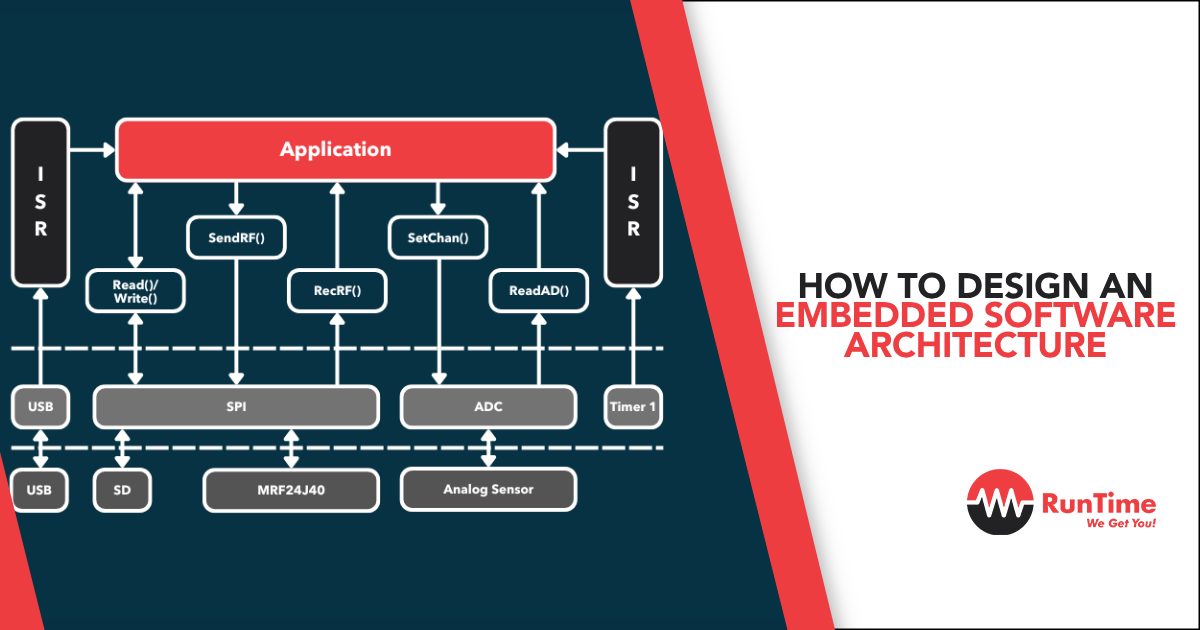In the world of embedded systems, designing a robust and efficient software architecture is paramount to the success of any project. Embedded systems are ubiquitous in our daily lives, from the microcontrollers in our household appliances to the sophisticated systems controlling autonomous vehicles. To create a reliable and well-structured embedded software architecture, one must follow a systematic approach that encompasses various stages. In this article, we will delve into a step-by-step guide on how to design an embedded software architecture.
Step 1: Separate the Software Architecture
In this initial step, the goal is to clearly define the boundaries between the software components and the hardware they interact with. This separation is crucial because it establishes the foundation for how your software will interact with the underlying hardware.
Key aspects to consider:
- Hardware Abstraction: Identify and abstract the hardware interfaces your software will use. This might include sensors, actuators, communication buses, and more. Abstraction simplifies interactions and promotes portability across different hardware platforms.
- Interface Definition: Clearly define how software modules will communicate with each other and with hardware. Well-documented interfaces make it easier to understand, develop, and maintain the system.
- Constraints and Requirements: Consider any hardware constraints, such as processing power, memory, or real-time requirements. These constraints will influence the design of your software components.
In essence, this step sets the stage by establishing a clear separation between the software and hardware realms, transforming intricate hardware specifics into manageable abstractions, defining robust interfaces, and acknowledging the constraints that will guide the subsequent stages of embedded software architecture design. This separation not only streamlines development but also promotes modularity, flexibility, and the adaptability required for a successful embedded system.
Step 2: Identify and Trace Data Assets
Data is the lifeblood of embedded systems. Identifying and tracing data assets involves understanding how data flows through your system and how it is processed.
Key aspects to consider:
- Data Sources and Sinks: Identify all sources of data input (e.g., sensors) and where the data is consumed or output (e.g., displays or actuators).
- Data Dependencies: Determine how different data elements depend on each other. This helps in designing algorithms and ensuring that data is processed correctly.
- Data Flow Diagrams: Create visual representations (diagrams) of data flow within your system. This provides a clear overview of how data moves through various components.
The process of identifying and tracing data assets is an essential phase in embedded software architecture design. It allows you to comprehend the flow and dependencies of data within your system, akin to understanding the circulatory and nervous systems of a living organism. This understanding not only informs the design of algorithms but also ensures that data is processed accurately, facilitating the creation of a well-structured, efficient, and reliable embedded system.
Step 3: Decompose the System
System decomposition involves breaking down your embedded system into smaller, manageable subsystems or modules. This is essential for managing complexity and facilitating parallel development.
Key aspects to consider:
- Subsystems: Define the major functional parts of your system. For example, in a robotic system, you might have subsystems for sensing, control, and actuation.
- Responsibilities: Clearly outline what each subsystem/module is responsible for. This helps avoid overlapping functionality and makes it easier to assign development tasks.
- Interfaces Between Subsystems: Specify how subsystems will communicate and share data. Well-defined interfaces are essential for seamless integration.
Breaking down your embedded system into well-defined subsystems, outlining their responsibilities, and specifying clear interfaces between them serve as a strategic approach for managing complexity and facilitating parallel development. This systematic breakdown of the system not only enhances the comprehensibility of your architecture but also fosters efficient development and integration, contributing to the overall success of your embedded project.
Step 4: Interface and Component Design
With your subsystems identified, you can now design the interfaces and components within each of them. This step ensures that each part of your system performs its intended tasks efficiently. Key aspects to consider:
- Interface Design: Detail the protocols and communication mechanisms used by different parts of your system to exchange information. Ensure that these interfaces are well-documented and adhere to standards.
- Component Responsibilities: Define the specific responsibilities of each component within a subsystem. Components should have clear roles, making it easier to develop, test, and maintain them.
- Performance Considerations: Take into account factors like processing speed, memory usage, and power consumption when designing components. Optimization may be necessary to meet performance requirements.
The process of designing interfaces and components within subsystems is a critical phase in crafting a well-structured embedded software architecture. This step acts as the linchpin that ensures efficient communication, clear delineation of responsibilities, and optimized performance. By giving careful attention to interface design, component responsibilities, and performance considerations, you pave the way for a robust, maintainable, and high-performing embedded system.
Step 5: Simulate, Iterate, and Scale
Simulation, iteration, and scalability are crucial for ensuring that your embedded software architecture is robust and adaptable to future needs.
Key aspects to consider:
- Simulation: Use software tools and simulators to test your architecture under various conditions and scenarios. This helps identify potential issues and performance bottlenecks early in the design process.
- Iteration: Be prepared to refine and adjust your architecture based on simulation results and feedback. Iteration is essential for improving the architecture’s efficiency and reliability.
- Scalability: Ensure that your architecture can accommodate future enhancements or changes without major overhauls. Well-designed interfaces and modular components make it easier to scale your system as requirements evolve [1].
Simulation, iteration, and scalability collectively fortify your embedded software architecture. Simulation provides early insights, iteration refines and optimizes the design, and scalability ensures that the architecture remains adaptable to future needs. Embracing these principles throughout the development process empowers you to create a robust, responsive, and enduring embedded system architecture that can withstand the test of time and evolving project requirements.
Related Article: Safety Standards for Embedded Systems Development
Conclusion
In summary, designing an embedded software architecture is a systematic process that involves careful planning, data analysis, decomposition, interface and component design, and iterative refinement. Following these steps helps create a solid foundation for building reliable and maintainable embedded systems.
Hire Top-Tier Engineers with RunTime Recruitment
Our expert team of engineers-turned-recruiters offers in-depth knowledge of technical recruiting in the engineering industry.
If your company is looking to recruit highly skilled engineers worldwide, contact us today and we will do the sourcing for you. Or if you’re an engineer looking for new opportunities, you can check RunTime Recruitment’s job site for job vacancies.









